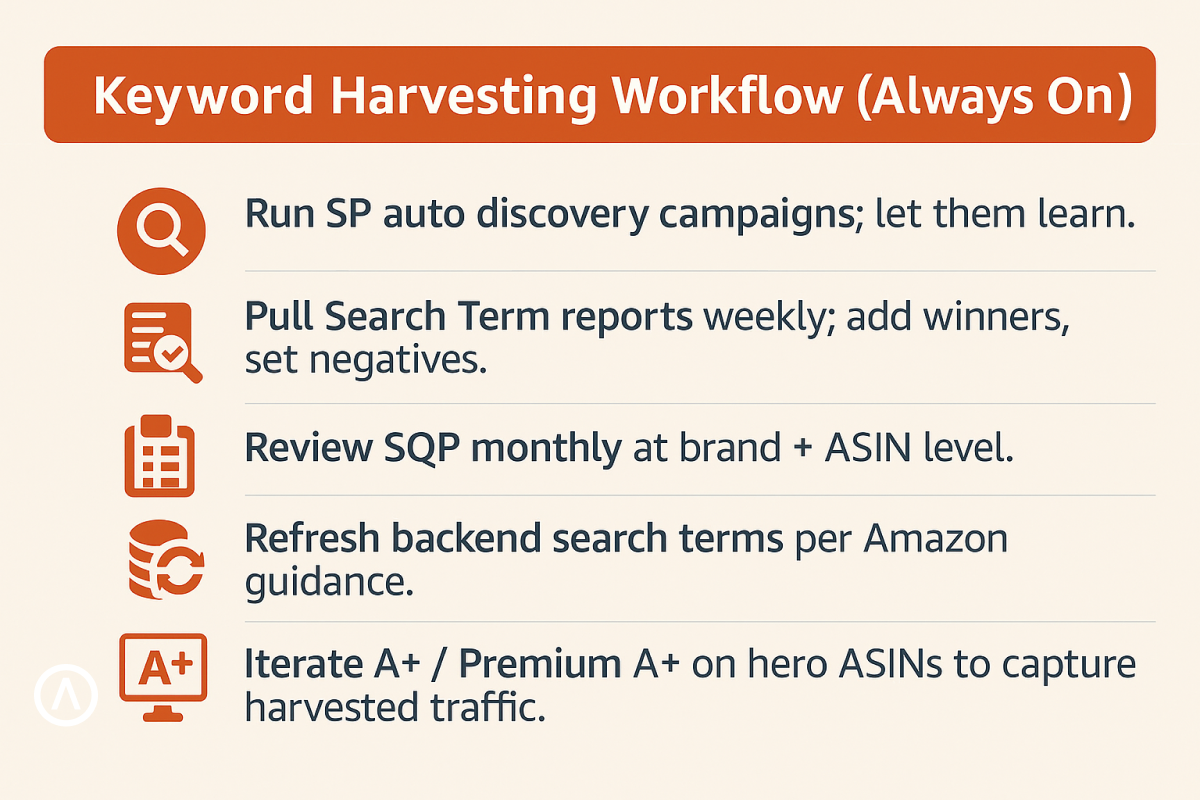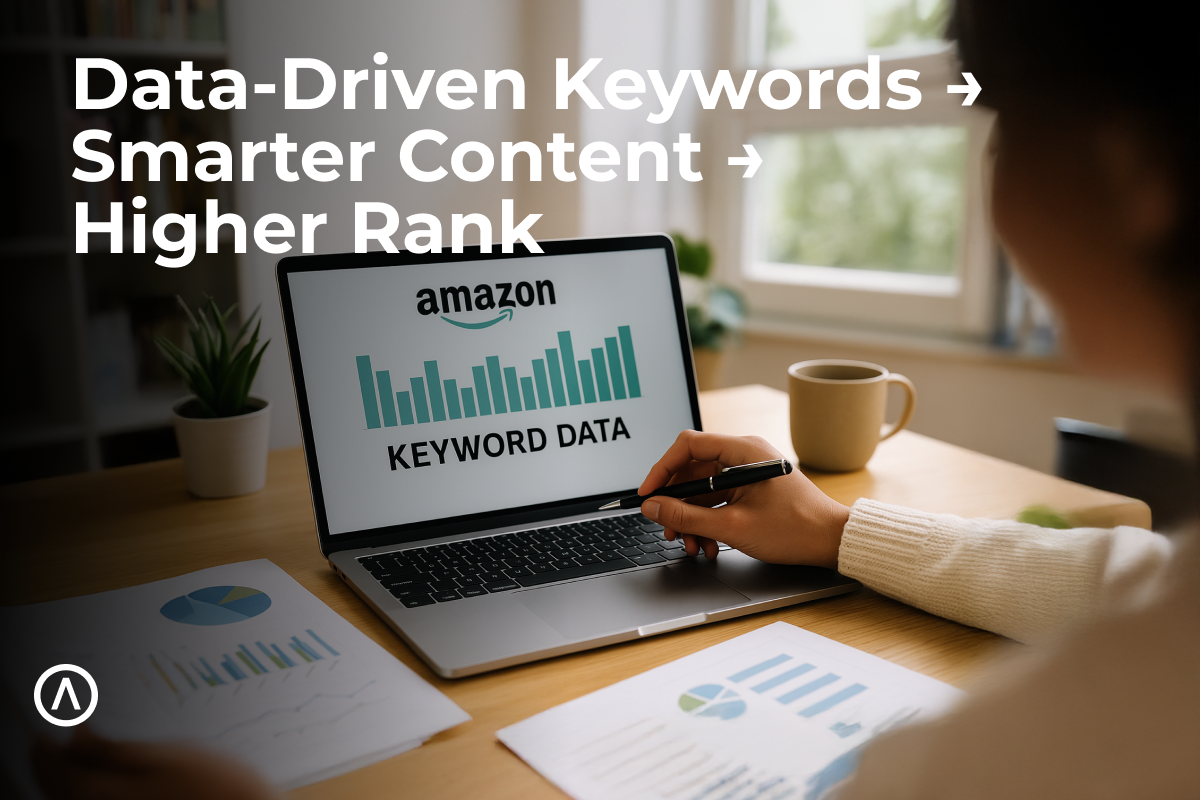If your Amazon SEO still relies on a one-time keyword list, you’re leaving compounding growth on the table. Shoppers don’t stay static, and neither should your strategy.
Keyword harvesting is the process of turning live shopper data—from auto campaign queries to Search Query Performance (SQP) and product insights—into continuous organic ranking lifts. Done right, it builds a self-reinforcing loop: more visibility → more traffic → better data → stronger content → even higher rankings.
Key Takeaways
- Let auto campaigns discover queries, then graduate winners to manual and negate the rest. Amazon recommends ~2 weeks of auto learning before moving to manual.
- Mine Search Term reports (SP/SB) to add winners and exclude waste.
- Use Brand Analytics (Top Search Terms, Search Query Performance) to see impressions→clicks→add‑to‑cart→purchases and your brand share at each step.
- Optimize listings + backend search terms to lock in organic gains (follow Seller Central guidance).
- Improve conversion with A+ / Premium A+; Amazon cites up to ~8% (Basic) and ~20% (Premium) sales lifts. (Sell on Amazon)
1. Let Amazon Discover Hidden Terms for You
Amazon’s ad engine is your first keyword scout.
- Auto campaigns: Give them ~2 weeks of learning to map real shopper searches.
- Graduation: Spin out winning terms into manual campaigns; negate underperformers to cut waste.
- Search Term Reports (SP/SB): Pull these weekly to capture high-performing queries and eliminate costly noise.
This way, your ads budget doesn’t just drive paid clicks—it becomes a keyword lab that fuels long-term SEO.
2. Unlock Deep Insights With Brand Analytics
Your next layer of keyword intelligence comes from Brand Analytics, one of Amazon’s most underused tools.
- Search Query Performance (SQP): See how your brand or ASIN performs across the funnel—impressions, clicks, cart-adds, purchases. Identify where you’re winning or losing visibility.
- Search Catalog Performance: Spot where buyers drop off at the ASIN level. Do you have a discoverability problem (keywords) or a conversion problem (content)?
- Top Search Terms: Capture broader demand trends and language beyond your campaigns.
By connecting SQP and ads data, you’ll see not only what shoppers type, but also how well your listings capture them.
3. Feed Harvested Terms Back Into Listings
Keyword harvesting is only powerful if you turn insights into action.
- Listing copy: Update titles, bullets, and descriptions with harvested phrasing. Always follow Seller Central best practices—avoid repetition, use synonyms, no competitor brand names.
- Backend fields: Refresh hidden search terms regularly to capture related demand.
- Content optimization: Support new keywords with A+ Content (spec tables, comparison charts). If eligible, upgrade to Premium A+, which Amazon cites as lifting sales by up to ~20%.
This closes the loop: harvested search terms → optimized content → higher organic rankings → more data to harvest.
4. Prioritize the Keywords That Matter Most
Not every keyword is worth chasing. Use data to filter for impact:
- High conversion potential: Terms where your purchase share is strong, even if your click share is weak. That means once shoppers find you, they buy—so boost discoverability.
- Search volume + intent: SQP and Product Opportunity Explorer highlight queries with real demand.
- Velocity impact: Keywords that drive steady orders improve sales history, which strengthens organic rank signals.
Prioritize these terms in listing copy and as manual campaign targets.
5. Track the Right Metrics to Prove It Works
Keyword harvesting success shows up in both ad reports and organic growth:
- SQP brand/ASIN share: Are your impressions, clicks, and purchase share rising?
- Search Term Impression Share (SP): Are you gaining visibility against competitors?
- Organic sessions & conversion (Business Reports): Is harvested traffic turning into sales?
This isn’t guesswork—it’s measurable, repeatable growth.

Think of it as a garden: keep pruning waste, feeding winners, and refreshing soil (backend + content). That’s how you compound rankings.
Keyword Harvesting FAQ
1. How long should I run auto campaigns before harvesting?
Amazon recommends ~2 weeks before building manual sets.
2. What’s the difference between keywords and search terms?
Keywords are what you bid on. Search terms are what shoppers actually type (found in reports + SQP).
3. Where can I find buyer-language keywords beyond ads data?
Brand Analytics (Top Search Terms, SQP) and Product Opportunity Explorer reveal demand and related searches.
4. Do backend search terms still matter?
Yes. Follow Seller Central’s rules: keep within character limits, use synonyms, avoid repeats.
5. How do I measure if harvesting improved ranking?
Track rising SQP share, organic sessions, and SP Impression Share on your target terms.
Continuous Harvesting = Compounding Growth
The fastest path to durable Amazon SEO isn’t a one-time keyword list. It’s continuous harvesting of real shopper queries, paired with credible content that converts.
Brands that build this flywheel—auto discovery → analytics → content refresh → A+ conversion—win durable organic share while competitors plateau.
Ready to 10x your visibility? Contact Algofy today and let’s build an SEO strategy that turns hidden searches into lasting growth.









.png)












